The Nobel Prize in Chemistry is one of the most prestigious honors in science, awarded annually by the Royal Swedish Academy of Sciences. It recognizes individuals or teams whose discoveries have significantly advanced the field of chemistry and often the broader scientific landscape.
Recent winners of the Nobel Prize in Chemistry
Nominations for the Nobel Prize are submitted by qualified individuals worldwide and reviewed by a Nobel Committee of experts. The selection process is confidential and rigorous, often taking years of deliberation and review of scientific impact.
The 2025 Nobel Prize for Chemistry was announced 8 October, 2025, recognizing research related to metal-organic frameworks (MOFs), revolutionary porous crystalline materials with tunable structures and high surface areas. MOFs extraordinary versatility makes them applicable platforms for addressing global challenges in environmental remediation, renewable energy, industrial catalysis, medical diagnostics, drug delivery, electronics, and sensing technologies.
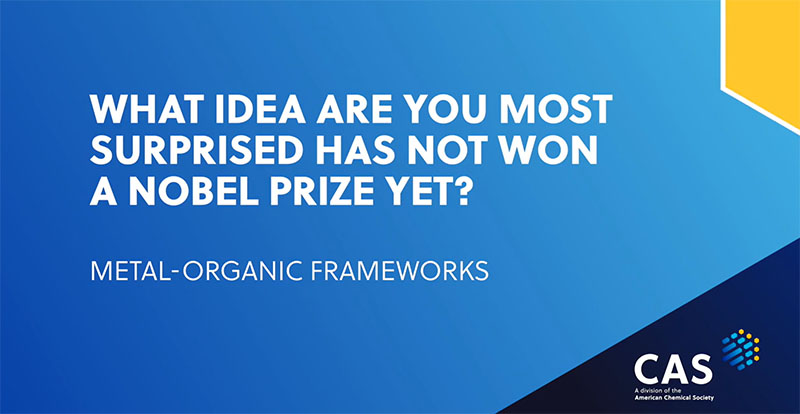
CAS scientists have had their eye on MOFs for some time (video), and suggested that it was, indeed, "Nobel ready."
For more on how MOFs are shaping the future of materials science, read what CAS scientsts say about how close they are to a "commercial tipping point."
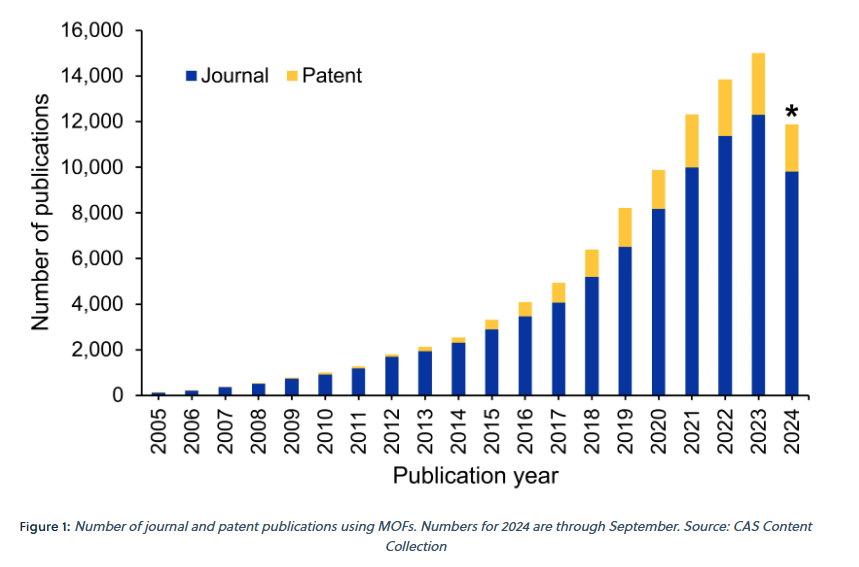
- 2024: David Baker was awarded for computational protein design, while Demis Hassabis and John Jumper were recognized for protein structure prediction using AI, notably AlphaFold2. Together, their work enabled the creation and understanding of proteins with unprecedented precision, transforming medicine and biology.
- 2023: Moungi G. Bawendi, Louis E. Brus, and Aleksey Yekimov received the prize for the discovery and synthesis of quantum dots, nanoscale particles whose properties change with size and are now used in everything from LED displays to cancer surgery. Their breakthroughs laid the foundation for modern nanotechnology.
- 2022: Carolyn R. Bertozzi, Morten Meldal, and K. Barry Sharpless were honored for pioneering click chemistry and bioorthogonal chemistry, which enable molecules to bond quickly and precisely, even within living organisms. Their work has revolutionized drug development and cellular imaging.
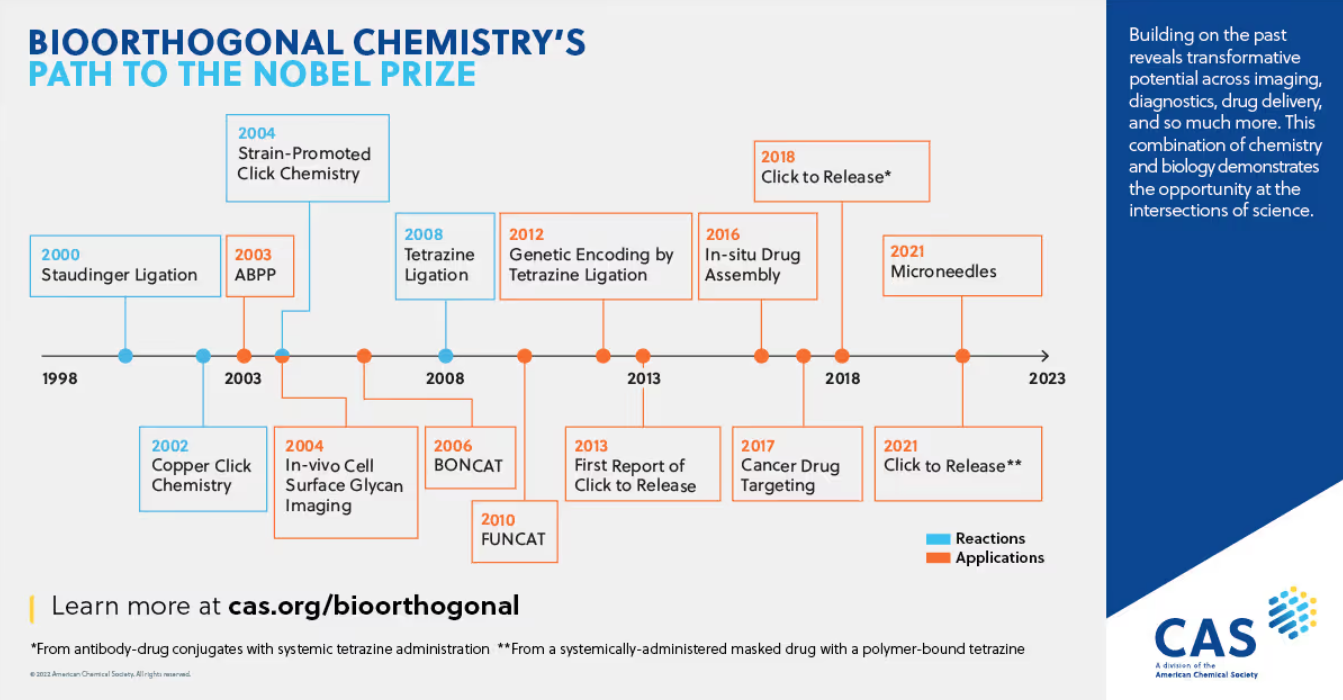
- 2021: Benjamin List and David W.C. MacMillan were jointly awarded the Nobel Prize in Chemistry for developing asymmetric organocatalysis, a method that uses small organic molecules to drive chemical reactions with high precision. This innovation has made molecular construction more efficient and environmentally friendly, especially in pharmaceutical research.
The 2025 Nobel Prize in Chemistry will be announced on Wednesday, October 8, 2025, at 11:45 CEST.
Three paths to a Nobel Prize in Chemistry
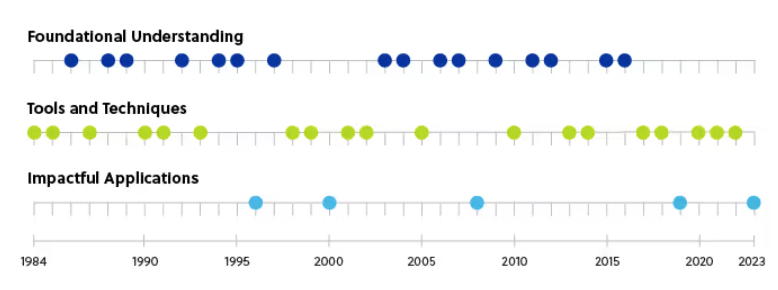
From the invention of CRISPR to the development of quantum dots, Nobel-winning research often follows one of three trajectories. Some discoveries lay the groundwork for entire fields. Many introduce transformative tools that accelerate innovation. A certain few deliver real-world applications that change lives.
In this exclusive analysis, CAS scientists examined the publication patterns, collaboration networks, and innovation timelines behind Nobel-winning work. The result? A data-driven three-path framework that explains past awards and may help predict future ones. Examples include:
Foundational understanding
- Mechanistic studies of DNA repair. Tomas Lindahl, Paul Modrich, Aziz Sancar. 2015.
- Atmospheric chemistry, particularly concerning the formation and decomposition of ozone. Paul J. Crutzen, Mario J. Molina, F. Sherwood Rowland. 1995.
- Catalytic properties of RNA. Sidney Altman, Thomas R. Cech. 1989.
Tools and techniques
- The development of a method for genome editing. Emmanuelle Charpentier, Jennifer A. Doudna. 2020.
- The development of super-resolved fluorescence microscopy. Eric Betzig, Stefan W. Hell, William E. Moerner. 2014.
- Chirally catalysed hydrogenation reactions and chirally catalysed oxidation reactions. William S. Knowles, Ryoji Noyori, K. Barry Sharpless. 2001.
Impactful applications
- The discovery and development of conductive polymers. Alan J. Heeger, Alan G. MacDiarmid, Hideki Shirakawa. 2000.
- The development of lithium-ion batteries. John B. Goodenough, Stanley Whittingham, Akira Yoshino. 2019.
- The discovery of fullerenes. Robert F. Curl Jr., Sir Harold W. Kroto, Richard E. Smalley. 1996.
One important finding of our analysis? Aspiring Nobel laureates must be patient. On average, 25 years elapse between publication of the seminal paper disclosing an initial discovery and that work being recognized with a Nobel Prize.
What could be the next Nobel Prize?
Scientific breakthroughs often begin with bold ideas that challenge convention, open new possibilities, and reshape entire fields. CAS scientists track emerging areas of innovation that have the potential to transform medicine, materials, and molecular design.
Here are some of our scientists’ insights into topics they believe are overdue for consideration by the Nobel committee.
Molecular editing. Pioneered by researchers such as Mark Levin, molecular editing includes techniques like C–H functionalization, skeletal editing, and late-stage diversification, molecular editing is redefining how chemists design and optimize pharmaceutical compounds. Instead of building molecules from scratch, this approach enables precise modifications to existing structures. These methods allow scientists to generate analogs rapidly with improved potency, selectivity, and pharmacological profiles.
Next-generation DNA Sequencing. Developed by Shankar Balasubramanian, David Klenerman, and collaborators, sequencing-by-synthesis technology has made genome sequencing faster, more affordable, and widely accessible. This innovation relies on reversible terminator chemistry, where fluorescently labeled nucleotides are incorporated one base at a time. The result is real-time detection of DNA synthesis with high accuracy and throughput. The impact spans personalized medicine, cancer treatment, pathogen identification, and global genomics research.
Solar cells. Advances in solar cell chemistry, particularly in perovskite and organic photovoltaics, have transformed renewable energy. Researchers such as Henry Snaith, Tsutomu Miyasaka, and Alex K.Y. Jen have developed hybrid materials that rival silicon in efficiency while offering low-cost, solution-based manufacturing. These technologies promise flexible, lightweight solar panels that can be printed and deployed globally. They address urgent energy needs through scalable chemical innovation and represent a significant step forward in sustainable energy solutions.
C-H activation and functionalization. C–H activation and functionalization, pioneered by John Hartwig, Jin-Quan Yu, and other leading researchers, represents a breakthrough in synthetic chemistry. This methodology has transformed how chemists construct complex molecules by enabling the direct conversion of traditionally unreactive C–H bonds into valuable C–C, C–N, C–O, and other bonds. By eliminating the need for pre-functionalized starting materials, C–H activation streamlines synthetic routes and reduces the number of steps required. The field includes major advances in transition metal catalysis, particularly with palladium, rhodium, and ruthenium systems.
Keep an eye out on this page for updates on Nobel Prize-winning science. Remember to sign up for CAS Insights alerts and get the latest research and trends delivered right to your email inbox.
Image credit: © Nobel Prize Outreach. Photo: Clément Morin.

